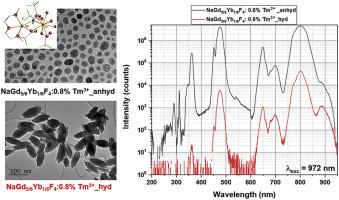当前位置:
X-MOL 学术
›
Mater. Today Chem.
›
论文详情
Our official English website, www.x-mol.net, welcomes your
feedback! (Note: you will need to create a separate account there.)
Quest to enhance up-conversion efficiency: a comparison of anhydrous vs. hydrous synthesis of NaGdF4: Yb3+ and Tm3+ nanoparticles
Materials Today Chemistry ( IF 6.7 ) Pub Date : 2020-09-01 , DOI: 10.1016/j.mtchem.2020.100326 B. Purohit , D. Amans , Y. Guyot , B. Mahler , M.-F. Joubert , C. Dujardin , S. Daniele , G. Ledoux , S. Mishra
Materials Today Chemistry ( IF 6.7 ) Pub Date : 2020-09-01 , DOI: 10.1016/j.mtchem.2020.100326 B. Purohit , D. Amans , Y. Guyot , B. Mahler , M.-F. Joubert , C. Dujardin , S. Daniele , G. Ledoux , S. Mishra

|
Abstract A major challenge in the field of up-converting (UC) nanomaterials is to enhance their efficiencies. The –OH defects on the surface of the nanoparticles are thought to be the main cause of luminescence quenching, but there are no comparative studies in the literature showing the impact of anhydrous vs. hydrous synthesis on up-conversion efficiency. In this article, we present the synthesis of up-converting NaGdF4: Yb+3, Tm+3 nanoparticles by two different methods: thermal decomposition of single source metal-organic anhydrous precursors [NaLn(TFA)4(diglyme)] (Ln = Gd, Tm, Yb; TFA = trifluoroacetate) and room temperature co-precipitation using hydrated inorganic salts Ln(NO3)3·5H2O (Ln = Gd, Tm, Yb), NaNO3 and NH4F in ethylene glycol. After a detailed study on the influence of solvents and the percentage of lanthanide dopant on the crystal phase of the up-converting nanoparticles (NPs) and their complete characterization, a comparative up-conversion study was carried out which revealed that the uniform nanospheres (av. size ∼13 nm) obtained from the anhydrous SSP had significantly higher up-conversion efficiency than agglomerated nanorods (∼197 nm in length and ∼95 nm in width) produced from hydrated inorganic salts. An enhanced up-conversion quantum yield of 1.8% for the anhydrous sample validates the anhydrous precursor approach as a strategy to obtain small but highly emitting up-converting particles without requiring a silica or undoped matrix surface passivation layer.
中文翻译:

寻求提高上转换效率:NaGdF4:Yb3+ 和 Tm3+ 纳米粒子的无水与含水合成的比较
摘要 上转换 (UC) 纳米材料领域的一个主要挑战是提高其效率。纳米粒子表面的 -OH 缺陷被认为是导致发光猝灭的主要原因,但文献中没有比较研究表明无水与含水合成对上转换效率的影响。在本文中,我们介绍了通过两种不同方法合成上转换 NaGdF4:Yb+3、Tm+3 纳米颗粒:单源金属有机无水前驱体的热分解 [NaLn(TFA)4(diglyme)] (Ln = Gd、Tm、Yb;TFA = 三氟乙酸盐)和使用水合无机盐 Ln(NO3)3·5H2O(Ln = Gd、Tm、Yb)、NaNO3 和 NH4F 在乙二醇中的室温共沉淀。在详细研究了溶剂和镧系元素掺杂剂对上转换纳米粒子 (NPs) 晶相的影响及其完整表征后,进行了比较上转换研究,结果表明均匀的纳米球 (av从无水 SSP 获得的纳米棒(长约 197 纳米,宽约 95 纳米)具有显着更高的上转换效率。无水样品的 1.8% 的增强上转换量子产率验证了无水前体方法作为获得小但高发射的上转换粒子的策略,而无需二氧化硅或未掺杂的基质表面钝化层。进行了比较上转换研究,结果表明从无水 SSP 中获得的均匀纳米球(平均尺寸为 13 nm)比团聚纳米棒(长度为 197 nm,宽度为 95 nm)具有显着更高的上转换效率) 由水合无机盐制成。无水样品的 1.8% 的增强上转换量子产率验证了无水前体方法作为获得小但高发射的上转换粒子的策略,而无需二氧化硅或未掺杂的基质表面钝化层。进行了比较上转换研究,结果表明从无水 SSP 中获得的均匀纳米球(平均尺寸为 13 nm)比团聚纳米棒(长度为 197 nm,宽度为 95 nm)具有显着更高的上转换效率) 由水合无机盐制成。无水样品的 1.8% 的增强上转换量子产率验证了无水前体方法作为获得小但高发射的上转换粒子的策略,而无需二氧化硅或未掺杂的基质表面钝化层。
更新日期:2020-09-01
中文翻译:

寻求提高上转换效率:NaGdF4:Yb3+ 和 Tm3+ 纳米粒子的无水与含水合成的比较
摘要 上转换 (UC) 纳米材料领域的一个主要挑战是提高其效率。纳米粒子表面的 -OH 缺陷被认为是导致发光猝灭的主要原因,但文献中没有比较研究表明无水与含水合成对上转换效率的影响。在本文中,我们介绍了通过两种不同方法合成上转换 NaGdF4:Yb+3、Tm+3 纳米颗粒:单源金属有机无水前驱体的热分解 [NaLn(TFA)4(diglyme)] (Ln = Gd、Tm、Yb;TFA = 三氟乙酸盐)和使用水合无机盐 Ln(NO3)3·5H2O(Ln = Gd、Tm、Yb)、NaNO3 和 NH4F 在乙二醇中的室温共沉淀。在详细研究了溶剂和镧系元素掺杂剂对上转换纳米粒子 (NPs) 晶相的影响及其完整表征后,进行了比较上转换研究,结果表明均匀的纳米球 (av从无水 SSP 获得的纳米棒(长约 197 纳米,宽约 95 纳米)具有显着更高的上转换效率。无水样品的 1.8% 的增强上转换量子产率验证了无水前体方法作为获得小但高发射的上转换粒子的策略,而无需二氧化硅或未掺杂的基质表面钝化层。进行了比较上转换研究,结果表明从无水 SSP 中获得的均匀纳米球(平均尺寸为 13 nm)比团聚纳米棒(长度为 197 nm,宽度为 95 nm)具有显着更高的上转换效率) 由水合无机盐制成。无水样品的 1.8% 的增强上转换量子产率验证了无水前体方法作为获得小但高发射的上转换粒子的策略,而无需二氧化硅或未掺杂的基质表面钝化层。进行了比较上转换研究,结果表明从无水 SSP 中获得的均匀纳米球(平均尺寸为 13 nm)比团聚纳米棒(长度为 197 nm,宽度为 95 nm)具有显着更高的上转换效率) 由水合无机盐制成。无水样品的 1.8% 的增强上转换量子产率验证了无水前体方法作为获得小但高发射的上转换粒子的策略,而无需二氧化硅或未掺杂的基质表面钝化层。











































 京公网安备 11010802027423号
京公网安备 11010802027423号